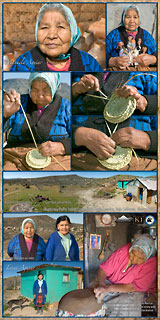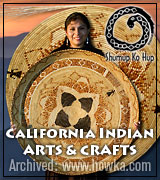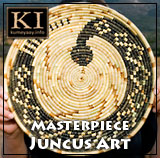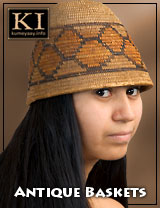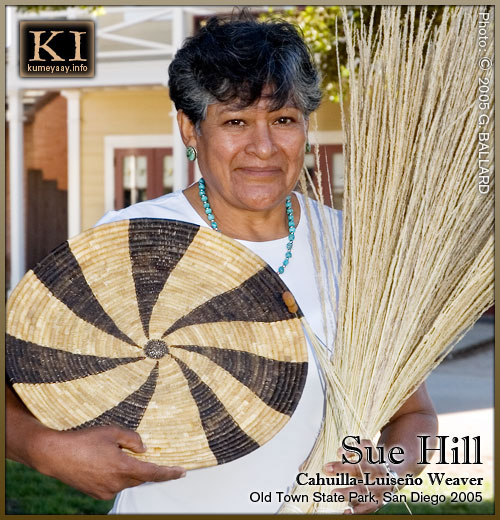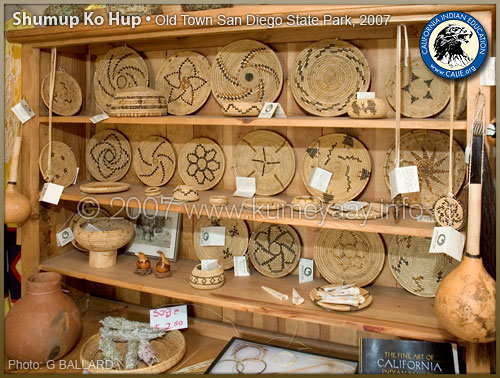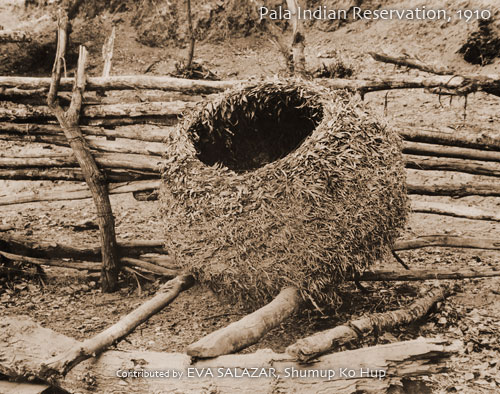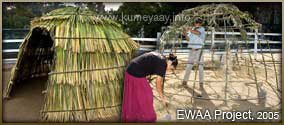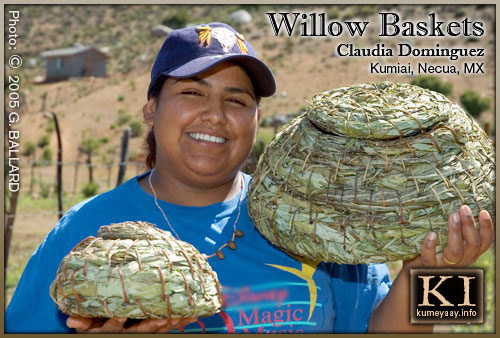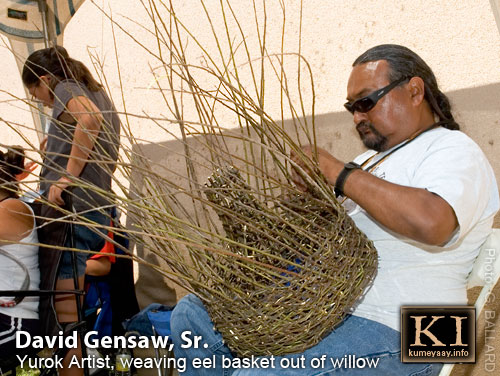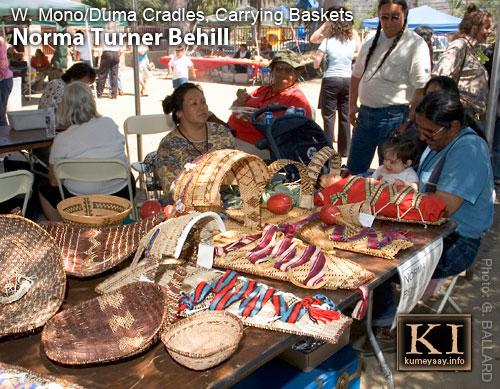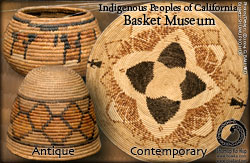 |
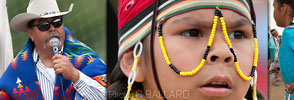 |
 |
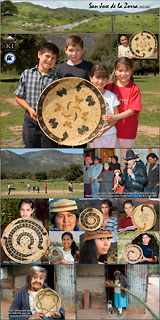
Publishing Corner: Indian Community: Science & Wonder Indian Heros: California Indian Art: CALIE Library: Academic Financial Aid: Tribal Governments: Indian Gaming: |
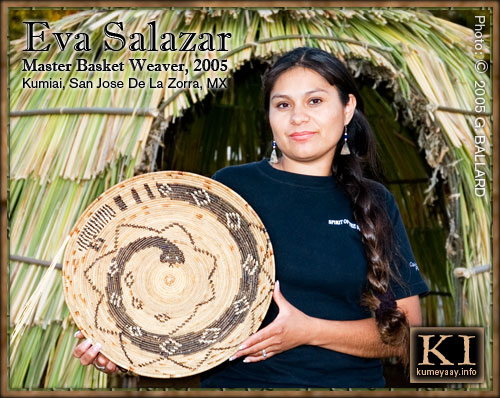
CALIFORNIA MISSION INDIAN BASKETSKumeyaay Indian master basket weaver Eva Salazar, Kumiai Indio de San Jose de la Zorra tribal community, Baja California, Mexico, posed for a professional Mission Indian basket picture in 2005 holding one of her unfinished (and now) famous masterpieces of Kumeyaay basketry while standing in front of a new pre-contact Kumeyaay- and Luiseño-style home that her brother, Fausto Diaz, built alongside their Shumup Ko Hup Indian store in Old Town State Park as cultural exhibit. Eva's traditional coiled juncus basket is constructed of natural split juncus, black-dyed juncus, with a deergrass foundation. The unique tribal design features a large coiled diamondback rattlesnake motif and an asymmetrical Indian star pattern. Note: The young Kumeyaay boy singing with the Cucapa bird singers in the top CALIE header is Eva's youngest child, Hampachoka — the young bird singers' picture was taken during the 2005 Old Town cultural fiesta (link contains various audio recordings, Native speakers, storytellers, arts and crafts, California Indian bird singing, pretty Indian girls dancing).
Sue Hill, a professional Cahuilla-Luiseño basket weaving artist, posed for a picture with one of her large high-end California Indian baskets.
Shumup Ko Hup California Indian store in San Diego Old Town State Park specialized in mid-range authentic coiled junkus baskets. COILED JUNCUS BASKET ARTThe indigenous peoples of Southern California, southwest Arizona and northern Baja California, Mexico, have been hand weaving coiled juncus baskets for hundreds if not thousands of years.
These tribal artists today include basketweavers of the Havasupai, Diegueño-Kumeyaay, Maricopa, Juaneño, Quechan, Mohave, Pai-Pai, Ipai-Tipai, Hualapai, Cocopah, Kiliwa, Yurok, Yavapai, Cahuilla, and Luiseño Indians of southwest USA, North America. It's only been within the last 150 years or so that the California Native basket makers, and their Native American basket art, have been generalized and labeled as "Mission Baskets." Mission Indian art is likely an 18th century marketing label coined to help the Indian artisans sell their ethnographic art to Spanish and white settlers beginning with the Mission Period in post-contact California Indian history. HISTORICAL INDIAN BASKETRY
This California Pala Band of Mission Indians historical Southern California Indian photo of a large full-sized Native American willow granary was titled "Pala, 1910," Pala Indian Reservation, San Diego County. WILLOW BASKET MAKING MATERIAL The willow leaves and branches used in these ancient types of food storage baskets contain SALICIN, a natural insect repellent, which is pretty effective at discouraging hungry insects from entering the basket and eating the traditional aboriginal food stores, acorns, pine nuts, grains. This natural "salicin" is why the California Indigenous peoples used willow in constructing their natural food granaries and even use willow to construct their pre-contact homes, sometimes referred today as an ewaa or kicha.
WILLOW BARK from the willow tree also contains salicin. Salicin contains an anti-inflammatory agent still used in aspirin today. The Native peoples have used willow bark as a medicinal tribal medicine for many hundreds, if not thousands of years in California. The Native Californians would fill their willow granary baskets with seeds and acorns for storage, sometimes leaving their granary baskets behind as they traveled the seasonal rounds to use when they returned to the area (and their shelters, seed and food stores would not be infested with bugs when they returned months later).
MINIATURE WILLOW BASKETS like the ones being displayed above by Kumeyaay weaver Claudia Dominguez in the San Antonio Necua Kumiai tribal village in Baja CALIF Mexico, are the sizes available in today's Indian gift shops, but the large full-size willow baskets may still be commissioned by today's traditional weavers for tribal, cultural education and museum exhibitions. CALIFORNIA INDIAN BASKETWEAVERS ASSOCIATION (CIBA) The California Indian Basketweavers Association CIBA vision is to preserve, promote, and perpetuate California Indian basketweaving traditions while providing a healthy physical, social, spiritual, and economic environment for basketweavers. We work to create a functioning network of basketweavers who support one another in their gathering and weaving activities, and who pass their tradition to the next generation.
PALA INDIAN RESERVATION 2005 — David Gensaw, Sr., Yurok artist, weaves an ancient-style eel basket used for fishing in California rivers. (Below) Norma Turner Behill, W. Mono Duma, also displayed her authentic California Indian basket art, including traditional handmade carrying baskets and Native American baby cradles of exceptional museum quality.
To learn more about Indian basketry in California, and see professional art portfolios of high-resolution basket photos, please visit the KUMEYAAY.INFO ONLINE BASKET MUSEUM: Page under creation, started by the webmaster on 1/25/09, last worked on 2/3/09... Please CONTACT the webmaster to submit articles or links for publication. |
CALIF INDIAN EDU NETWORK: AHMIUM.org | SCAIR.org | SDICENTER.org | APAPAS.com
—
WEB SITE DESIGN
www.calie.org COPYRIGHT 2008-Present • ALL RIGHTS RESERVED
